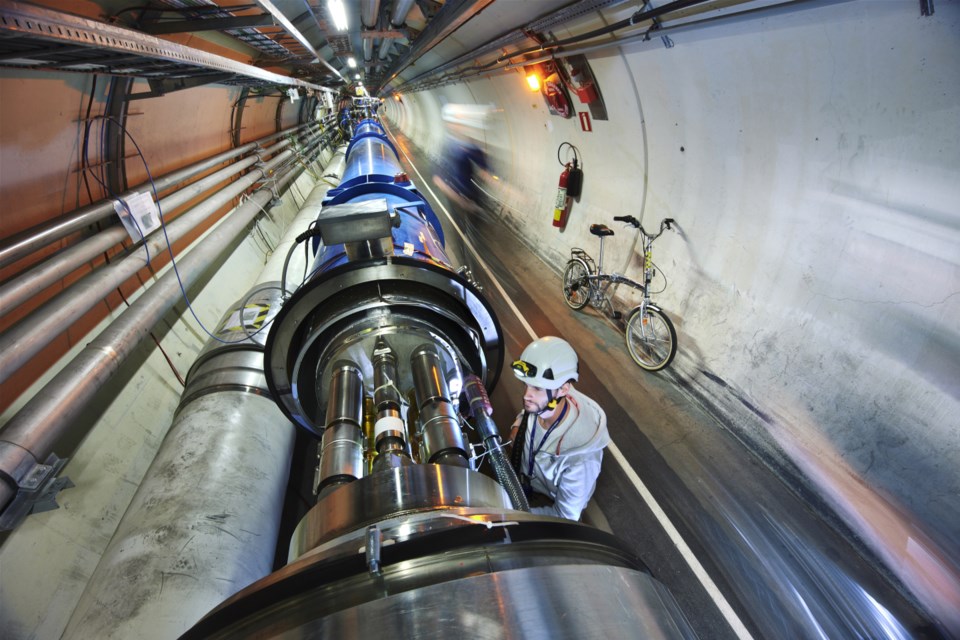It’s been 10 years since the announcement of the discovery of the Higgs boson particle, and Simon Fraser University’s own professor and particle physicist Michel Vetterli was in Geneva when it happened.
In 2012, Vetterli worked with ATLAS at CERN in Geneva. He said the researchers, some of whom had been working on the project for 20 years, were giddy.
The night before the announcement, Vetterli stopped by the auditorium where the media event would be held.
“There was already a lineup out the door. So I went home, took a shower, called my friend and said, ‘You better get there now, or you’re not getting in.’”
Vetterli staked out a place in line at 4 a.m., waited five hours, and got a coveted spot in the audience.
“It felt like waiting in line for a rock concert,” he said.
Vetterli says it’s still too soon to know what the applications of this knowledge are.
“People often ask me, ‘What good is the Higgs boson going to do, you know, what are we going to get?’ And the answer is, I don’t know because it’s still too early,” Vetterli said.
“But history tells us that all these main, big discoveries in pure science end up having application in everyday life,” he continued, pointing to discoveries like electricity or radioactivity, that have resulted in technology like medical imaging, CAT scanning and cancer treatments.
What is the so-called “God particle” — and why do physicists hate that term?
It all starts with subatomic particles.
What is a particle anyway?
Vetterli said the goal of nuclear and particle physicists is to find out what the building blocks of matter are.
“If I gave you a big box of Legos to build the world, what would the Legos look like?” he said.
He uses water as an example.
“If you divide up water, and you keep dividing it, it’s still water. But at some point, when you break it up, it’s hydrogen and oxygen,” he said.
“And when you keep breaking those up, you end up with nuclei and protons, and you just keep getting smaller and smaller. And eventually, you get to the point where you can’t break them up anymore — at least we can’t yet. And those are what we call elementary particles.”
For example: an electron.
“We’ve tried as hard as we can, we can’t break up an electron,” said Vetterli.
Quarks are another elementary particle, which make up the protons and neutrons that make up the nuclei of atoms.
These subatomic particles are fundamental at 10-18 meters (that’s 0.0000000000000000001 metres). Physicists haven’t found particles smaller than that.
Now: the particle accelerator.
This machine smashes subatomic particles together at extremely high speeds to create new particles.
“One of the things that an accelerator does is it pumps a lot of energy into a small space, and it pumps enough energy that mass can be created, and those are new particles.”
It’s Einstein’s e=mc² equation in action, which says mass and energy are equivalent.
“If you pump enough energy into a very small volume, then it can turn into mass,” Vetterli said.
“Where there was nothing before, there’s now a massive particle.”
Here comes Higgs boson
At CERN in Geneva, the Large Hadron Collider is the particle accelerator that smashed together the energy that created the Higgs boson particle (pronounced bo-zon).
The particle, while highly unusual, isn’t the important discovery in and of itself.
Rather, the particle proves the existence of what’s called the Higgs field — a field that permeates everywhere.
Vetterli once again uses a water metaphor.
“We’re swimming in a sea of Higgs field. … As subatomic particles move through it, they feel resistance, they interact with it, and that’s what creates mass.”
The interaction between the subatomic particles and the Higgs field is what gives those particles mass.
A common misconception is that the Higgs boson is responsible for all mass. Not quite.
The Higgs field is only responsible for the mass of subatomic particles (like those electrons and quarks).
“But if the subatomic particles had no mass, they’d all be whizzing around so fast that they’d never be able to agglomerate into things like protons. You wouldn’t have atoms, you wouldn’t have matter, you wouldn’t have people,” said Vetterli. “The universe would just be a bunch of elementary particles whizzing around at super high speed.”
“The Higgs is very important because it’s the thing that starts the chain of how you make mass, and therefore, how you end up with the matter that we see around us.”
What’s wrong with calling it the ‘God particle’?
The Higgs boson particle was first theorized in the 1960s. Scientists with particle accelerators were always looking for it.
According to physicist legend, the director of Fermilab accelerator lab in Illinois, Leon Lederman, was asked by a reporter “What is this Higgs particle? You ever going to find it?”
Lederman responded: “I’m so sick and tired of hearing about that goddamn particle.”
And yet, the press reported it as the “God particle.” (The publisher of Lederman’s 1993 book The God Particle also wouldn’t let him title it The Goddamn Particle either.)
Vetterli said physicists hate the term — “it’s very pretentious,” he says.
As for the future of the Higgs boson, Vetterli says it’s up in the air.
“The most exciting thing is you don’t know, right? Who knows, 50 years from now, maybe everybody will know what a Higgs boson is because it’s crucial to some new technology. It’s very hard for me to imagine that, but you never know.”
Vetterli works as the project leader at with Drs. Bernd Stelzer, Matthias Danninger and Dugan O’Neil.
SFU hosts the Canadian Tier-1 data centre, which is one of 10 centres worldwide to store and analyze the data from ATLAS and CMS Collaborations at the Large Hadron Collider in CERN.

